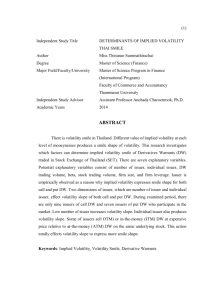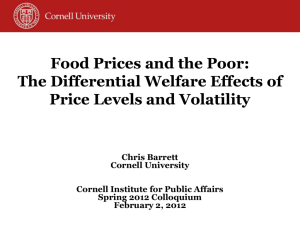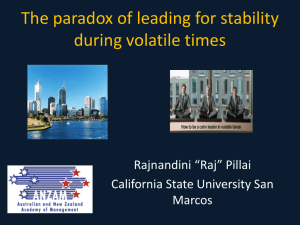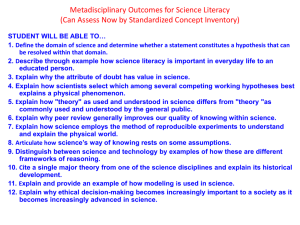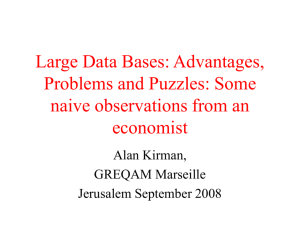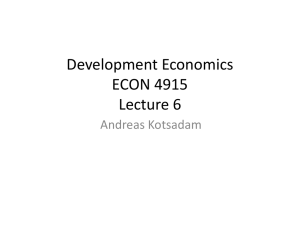Here
advertisement
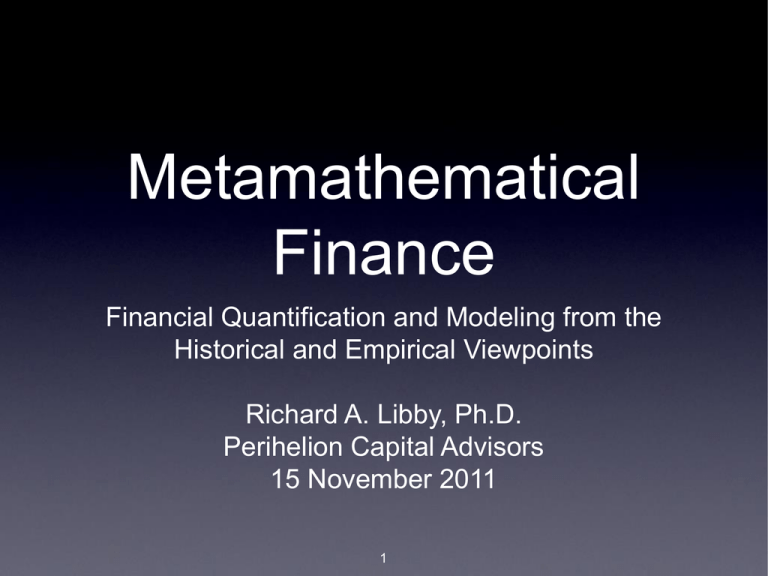
Metamathematical Finance Financial Quantification and Modeling from the Historical and Empirical Viewpoints Richard A. Libby, Ph.D. Perihelion Capital Advisors 15 November 2011 1 Some Definitions • Mathematics: the abstract science of numbers • Mathematical Finance: the application of mathematical methods to finance • Metamathematics: the mathematical study of mathematics itself 2 Metamathematical Finance • Definition: the mathematical study of Mathematical Finance • Primary tools: . study of model-driven behavior . evolution equations . self-referential paradox 3 Pre-History • Pascal and Fermat: probabilities of gaming, mid 1600’s • The Bernoulli family, de Moivre, et. al.: laws of large numbers, early to mid 1700’s • Gauss, Laplace, Legendre, et. al.: error analysis of large data sets, ~1800 • Boltzmann: statistical mechanics, 1870’s 4 1900 • Louis Batchelier examined randomness in stock prices on the Paris Bourse and wrote his PhD dissertation adapting the use of normal distributions to the analysis of price dynamics * Bachelier, L. (1900), Théorie de la spéculation, Annales Scientifiques de l’École Normale Supérieure 3 (17): 21– 86 5 20th Century • Markov: change-of-state models, 1906 • Pareto-Levy: “stable” fat-tail distributions, 1920’s • Kolmogorov: modern probability theory, 1930’s • Poincare to present: Dynamical Systems 6 Markowitz • Wrote his Ph.D. thesis in 1952 on the use of covariance in portfolio management, seeking to bring the impact of uncertainty into the analysis of stock price dynamics 7 risk-return of possible portfolios 1960’s and 1970’s • Beginnings of index funds (Bill Sharpe, et.al.) • Mandelbrot’s rejoinder: evidence of fat tails • The Chicago School and the Efficient Market Hypothesis • Black, Scholes and Merton price options using stochastic PDE and geometric Brownian motion 8 The Early 1980’s: Temporary Plateau • Mathematical Finance: risk management “in Hilbert Space” • Financial markets as a “Gaussian copula” • Growth of Structured Finance (Salomon Bros., Drexel, et. al.) 9 Gaussian copula density Trouble in Paradise • Sovereign default revisited: the Latin America banking crisis, early 1980’s • Foreign exchange risk after the Plaza Accord, 1985 • The Crash of 1987 • The Savings and Loan debacle, 19851989, and the first mortgage securities meltdown 10 More Event-Driven Markets • The first derivatives scandals, early 1990’s • The Asia Crisis, 1997 • Russia, Brazil and Long-Term Capital Management, 1998 and 1999 11 Ponzi Finance • Bubble equity markets: the Dot-Com era, 1997-2000 • The Housing Bubble, 2000-2006 • The collapse of the CDO market, 2007, and the rest of leverage finance, 2008 • Bear, Lehman and AIG, 2008 • From Iceland to Greece, 2008 to present 12 Taleb’s “Black 1 Swan” • A critique of Gaussian statistical reasoning • Abnormal becomes the new normal. Is the rara avis becoming too common? 1 Rara avis in terris nigroque simillima cygno, “a rare bird in the lands and very like a black swan” (Juvenal) 13 Stating the Problem • The Yogi Berra Principle: In theory, there is no difference between theory and reality, but in reality, there is. 14 Patterns in Thinking 1 • Deductive reasoning: logical inference from accepted truths • Inductive reasoning: inference from repeated and correlative experiences • Abductive reasoning: conceptual organization of related ideas and experiences 1. Charles Sanders Peirce, Deduction, Induction, and Hypothesis,1878 15 Problem Diagnosis • Mathematical Finance relies too heavily on deductive reasoning, not enough on inductive reasoning, and its abductive reasoning is skewed by the imbalance between deductive and inductive reasoning 16 Egregious Example One • The person with a negative IQ Intelligence tests are calibrated to a mean of 100 and a standard deviation of 16, placing zero at 6.25 standard deviations below the mean. Under a Gaussian distribution the probability of a negative IQ calculates to about 1 in 5 billion. 7 billion people inhabit the earth, so therefore... Lesson to be learned: don’t refine within the margin for error • Primary culprit in finance: Overleverage 17 Egregious Example Two • If Galileo employed linear regression... Galileo’s experiment dropping cannon balls from the Tower of Pisa has a very good linear fit for the data. time (seconds) = 1.243 + 0.0375 distance (meters) Lesson learned: only use tools consistent with the structure of the problem • Primary culprit in finance: ignoring convexity when using linear regression G. van Belle, Statistical Rules of Thumb, Wiley, 2002, pp. 3-4. 18 Anscombe’s Quartet • Identical linear regressions; data structures otherwise ignored y1 = 0.50 x1 + 3.00 y2 = 0.50 x2 + 3.00 y3 = 0.50 x3 + 3.00 y4 = 0.50 x4 + 3.00 19 Worked Example One • Problem: the volatility of volatility The volatility measurement of a financial time series depends on the historical sample more than “sample noise” would predict 20 Real vs. Model Volatility • Compare GS equity 60-day volatility with that of random draws from a standard normal distribution 21 Reality versus Theory • Real volatility shows clear secular behavior; stochastic model volatility does not • Stochastic model volatility is completely described by the principle of small sample noise; real volatility is not 22 Searching for Structure • Real volatility shows a dependence on underlying liquidity; the stochastic model does not even consider market liquidity 23 Liquidity-Driven Volatility • We can see this liquidity-driven volatility in a comparison of actual percentile changes against theoretical changes under a normal distribution 24 Modeling Liquidity • The driver of the non-normality is in the right-hand tail: periods of very high trading volume 25 The Central Limit Theorem May Not Apply • Fact I: GS trade volume has an unbounded distribution (it looks lognormal) • Fact II: Daily volatility is slightly superlinear in daily trading volume • Therefore: GS price dynamics have an unbounded component, violating the requirements of the Central Limit Theorem 26 Conclusion • GS price dynamics are not normally distributed (but we already knew that from experience)! 27 Help from Macroeconomics • Empirical evidence shows liquidity drives volatility • Basic macroeconomics would agree: MV = PQ so M dV = dP Q 28 Worked Example Two • Problem: the volatility of correlation 29 S&P 500 v 10 Year Treasuries • Correlations are heavily time-dependent 30 S&P 500 v 10 Year Treasuries • But a third asset class helps explain why: 31 Exogenous correlation sources • When money market rates are high, equity and treasury markets tend to be positively correlated • When money market rates are low: equity and treasury markets tend to be negatively correlated 32 Equities & Bonds Money Markets Equities Bonds Money Markets Why Metamathematics? • 1800’s: mathematics expands; the “easy” problems get solved • Late 1800’s: mathematicians find counterexamples to “proved” theorems and begin to ask “what is a proof?” • 1900: attempts at a logical foundation for mathematics fail due to selfreferential paradox (Bertrand Russell) 33 Self-reference in Finance • Step I. • Step II. Financial markets are modeled People learn and use the models, changing their behavior in the process • Step III. As a result, financial markets no longer match the models • Step IV. Disaster strikes 34 Another Quote • Yogi Berra: Nobody goes there anymore: it’s too crowded. 35 A Metamathematical Model • Early 1900’s: Lotka and Volterra model population dynamics xt = a x - b x y yt = c x y - d y x is the “prey” y is the “predator” (constants a, b, c, d > 0) 36 Heuristic Application to Finance • We’ll make x the model practitioners, y the other side of the market • Step I. Model is new, |x| is small, |b xy| is negligible, so xt >> 0 • Step II. Model is now widely used, the other side of the market develops a counter-strategy, so |b xy| grows, as does |c xy|. As a result, yt >> 0 37 Application (cont’d) • Step III. x faces dramatic losses; the model is discredited. xt << 0 • Step IV. With x in full retreat, y begins to “starve”: |c xy| is now too small to offset |d y| and as a result yt << 0 38 Basic Lotka-Volterra • The basic Lotka-Volterra model shows cyclical behavior a=1 b=1 c=1 d=1 39 Extended LotkaVolterra • Of course, the model can be extended by letting the parameters vary a = 1.5 - xt b=1 c=1 c=1 40 Conclusion • Point #1: Financial modeling, like scientific modeling, requires both analytical and observational skills • Point #2: The reservoir of potential but unused mathematical methods is large • Point #3: Bad models become victims of their own failures, while good models become victims of their own successes 41 Q&A 42


![[These nine clues] are noteworthy not so much because they foretell](http://s3.studylib.net/store/data/007474937_1-e53aa8c533cc905a5dc2eeb5aef2d7bb-300x300.png)


